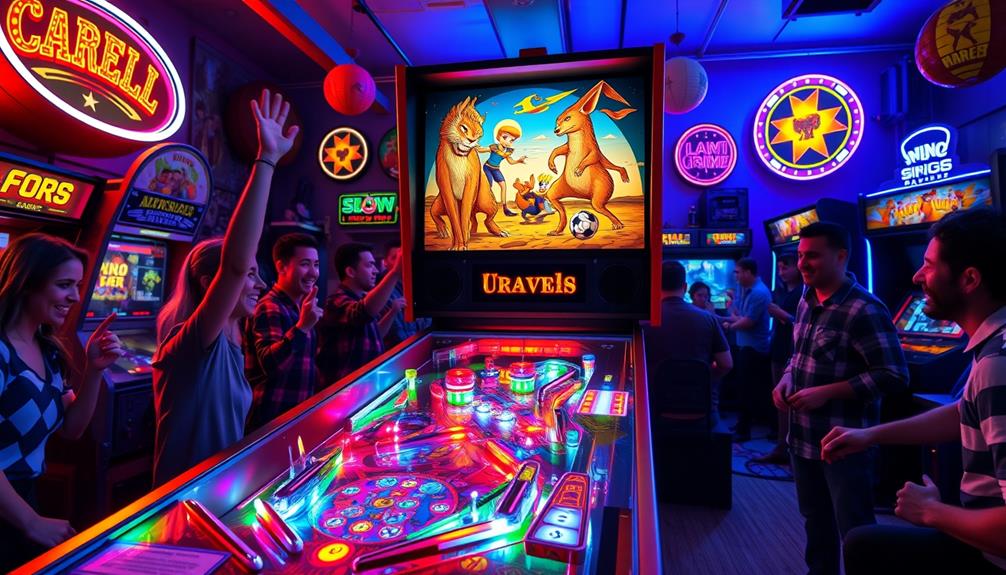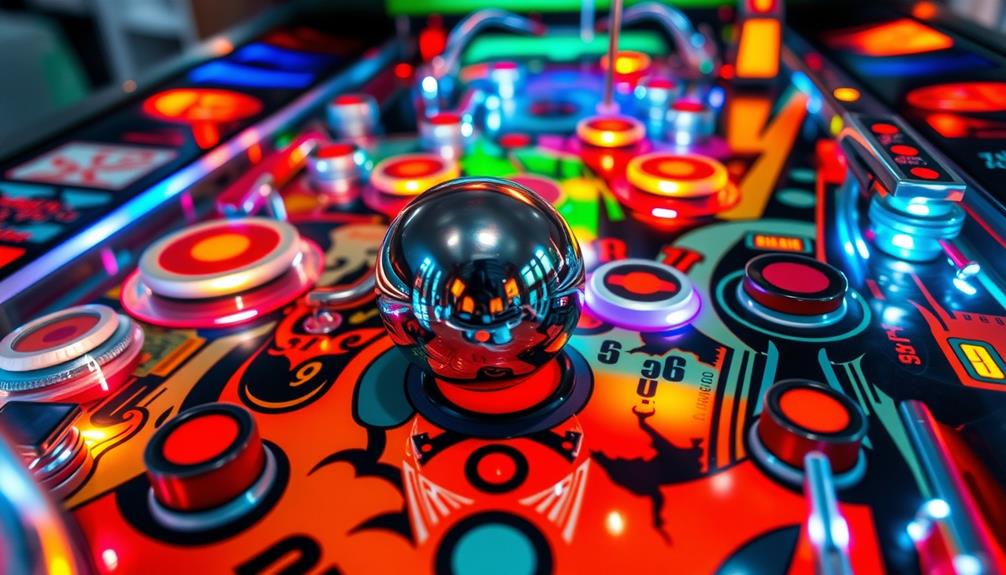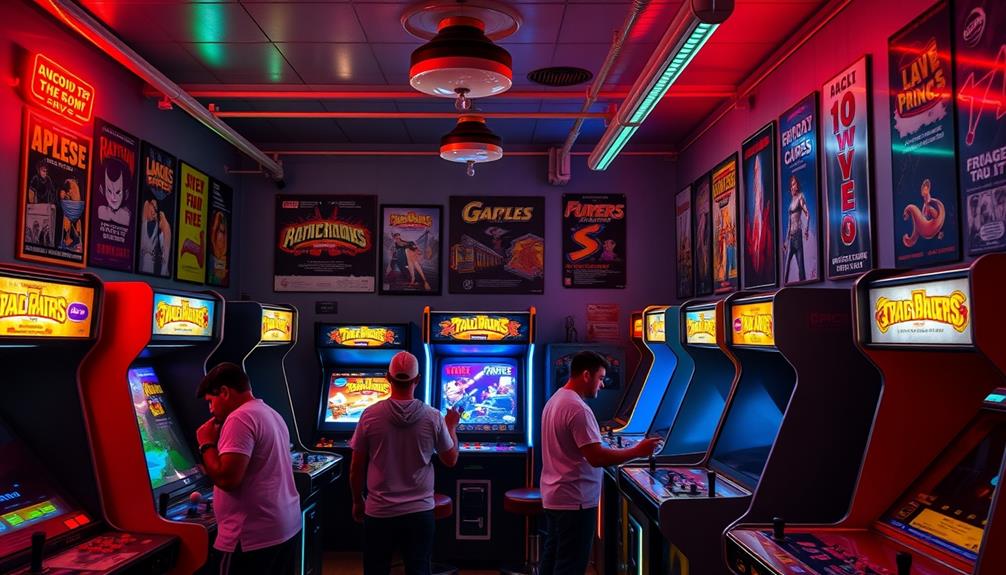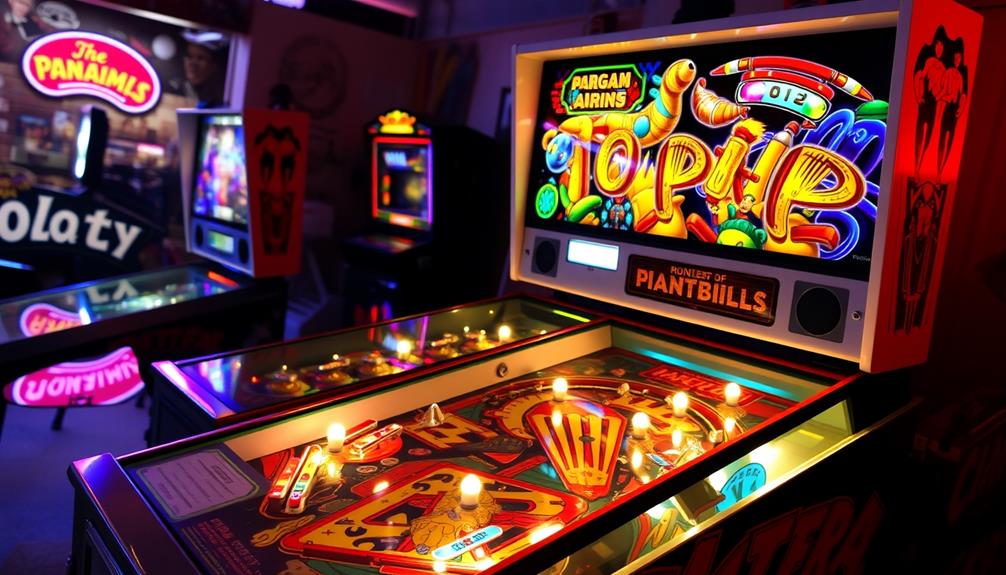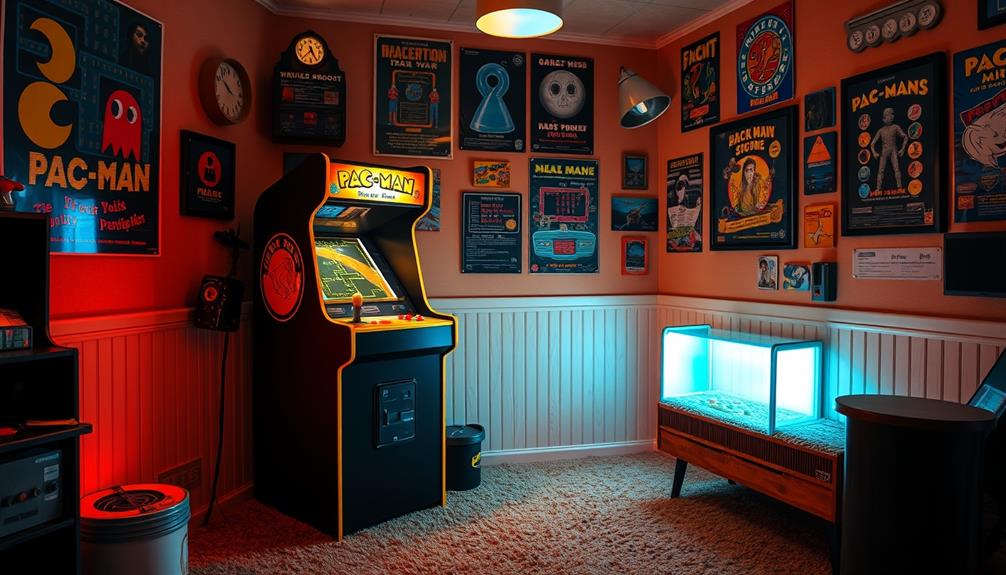A pinball machine operates by integrating mechanical parts that provide a captivating gameplay experience. You use buttons to control flippers and strike the ball to prevent it from falling down. The slanted playfield influences the ball’s movement, while bumpers and obstacles change its speed and direction. Points are earned by hitting specific targets, completing goals, and activating bonus features. The dot-matrix screen displays your score and highlights scoring opportunities. Understanding these aspects can enhance your gameplay and tactics. Keep exploring to discover more about mastering this traditional arcade game and boosting your scoring potential. Pinball machine components like the plunger, ramps, and spinners add excitement to the gameplay. The sound effects and flashing lights enhance the overall sensory experience, making players feel fully engaged in the game. Mastering the timing and control of these elements is crucial for achieving high scores and maximizing the enjoyment of playing a pinball machine.
Key Takeaways
- Pinball machines operate on an inclined playfield, allowing gravity to influence ball movement and scoring potential.
- Flippers direct the ball's trajectory, while bumpers create unpredictable interactions to enhance gameplay dynamics.
- Scoring is achieved by hitting targets, completing tasks, and activating jackpots, with real-time scores displayed on dot-matrix screens.
- Special modes like Casino Frenzy lead to multi-ball scenarios, increasing scoring opportunities and gameplay excitement.
- The match feature offers a chance for free games by matching score digits, adding an element of suspense to gameplay.
Understanding Pinball Mechanics
In pinball, understanding the mechanics is vital for mastering the game. A pinball machine comprises various mechanical and electronic components working together to create an engaging experience. At the heart of the action is the playfield, inclined at about 6.5 degrees to encourage the ball's movement. This angle also interacts with obstacles like bumpers, ramps, and targets, adding complexity to your gameplay.
Additionally, ideal angles for pinball machines can greatly enhance gameplay performance, allowing for better ball behavior and scoring potential ideal angles for gameplay.
You control the flippers located at the bottom of the playfield using buttons positioned beneath the glass top on either side of the machine. Mastering the timing and angle of your flipper shots is essential for hitting specific targets and achieving high scores.
Launching mechanisms, whether a plunger or solenoid activation, send the ball into play, and the tilt mechanism guarantees fair play by detecting when the machine is shaken excessively.
As you navigate the playfield, your score increases by completing tasks and striking targets, all displayed on the dot-matrix display. By grasping these mechanics, you can enhance your gameplay and increase your chances of winning.
Embrace the intricacies of the pinball machine, and you'll find yourself improving with each game.
Key Components of a Pinball Machine

When you play a pinball machine, flippers and bumpers are your main tools for keeping the ball in action. The flippers let you control the ball's direction, while bumpers add excitement by launching it around the playfield.
Additionally, many modern machines incorporate advanced technology and design for a more immersive experience, as seen in the best rated pinball machines of 2024.
Understanding how these components work will enhance your gameplay and scoring strategies.
Flippers and Bumpers
Flippers and bumpers act as the primary tools that shape your pinball experience, combining to create an exhilarating gameplay dynamic. When you press the buttons, the flippers, powered by solenoids, swiftly move to hit the ball and redirect its path. This interaction is vital for controlling the pace of the game.
Pinball machines utilize a variety of mechanical and electronic components to enhance gameplay, including key elements of pinball design that create an immersive experience. Bumpers, on the other hand, are strategically placed around the playfield. They react when the ball makes contact, sending it in unexpected directions and enhancing the thrill of the game.
Here are three key aspects of flippers and bumpers:
- Flippers: Mechanical levers that you control to hit the ball, essential for keeping it in play and aiming for targets.
- Bumpers: Spring-loaded devices that propel the ball upon contact, adding random movement and excitement.
- Interaction: The combination of flippers and bumpers influences the ball's speed and trajectory, impacting your overall score and gameplay experience.
Understanding these components helps you master the game and enjoy the rollercoaster of challenges and rewards that pinball offers.
Scoring Mechanisms Explained
Understanding how scoring works in pinball adds another layer to your gameplay experience. In modern machines, scoring is dynamic, often based on hitting specific targets, completing tasks, and activating jackpots. Each combination shot can lead to increased bonuses, making strategic play essential.
You'll notice a dot-matrix display board showing your current score and providing gameplay hints, typically in resolutions like 128×32 or 192×64 pixels. For instance, just as essential oils like clove oil offer specific benefits for toothache relief, each pinball target can contribute uniquely to your overall score.
One exciting feature is the match system, which randomly selects a multiple of 10 (00-90). If your score matches this number, you could win a free game—though it usually happens with a probability of 7% or less.
Replay value screens indicate the score you need for that coveted free game, with only the top 10% of scores typically exceeding this threshold, set at 150% of the previous replay value to heighten the challenge.
Advanced scoring mechanisms like Casino Frenzy and Super Jackpot create special scoring opportunities during gameplay, enhancing the depth of the scoring system. Mastering these aspects won't only boost your score but also elevate your overall pinball experience.
Gameplay and Scoring Systems

In pinball, understanding scoring mechanics is key to boosting your points.
Different gameplay strategies can greatly enhance your score, much like how various brewing methods affect caffeine content in coffee various brewing methods.
You'll need to master game strategies that can help you rack up bonuses and rewards.
As you play, keep an eye out for special features that can lead to high scores and extra chances to play.
Scoring Mechanics Explained
Scoring mechanics in pinball machines can be both exciting and complex, engaging players through various ways to rack up points. Understanding these scoring mechanisms can enhance your gameplay experience and elevate your scores.
Many players also find joy in the nostalgic aspects of pinball, similar to how Blue Skies and Lemonade by Rhythm Failure evokes feelings of joy and warmth.
Here are three key ways to earn points:
- Targeting Specific Ramps: In some pinball games, like High Roller machines, hitting specific ramps activates poker-like scoring systems, allowing you to earn significant points through strategic shots.
- Completing Tasks: Many machines have tasks that, when completed, release jackpots and bonuses. These tasks can involve hitting designated targets or achieving specific objectives during play.
- Casino Frenzy Mode: Once you've won all games, you can activate Casino Frenzy mode. This feature presents Super Jackpot opportunities during multi-ball play, where hitting certain targets can lead to massive point gains.
Additionally, don't forget about the match feature, which offers a chance for a free game by matching the last two digits of your score.
This adds an element of luck to your gameplay, making the scoring experience even more thrilling!
Game Strategies for Success
While steering a pinball machine, your success hinges on mastering its unique gameplay strategies and scoring systems. Each pinball game presents specific objectives, often requiring you to hit certain targets or complete tasks to boost your score.
To enhance your gameplay, consider leveraging high-quality content that explores various pinball strategies and techniques. Pay attention to the dot-matrix display board; it provides real-time scores and hints that can guide you toward valuable scoring opportunities.
Utilizing combination shots is a key strategy for activating jackpots and scoring bonuses. Experienced players have learned to exploit the machine's design by identifying sequences and patterns that maximize points.
Focus on these patterns to enhance your gameplay and make the most of your time at the machine.
If you're playing a High Roller machine, you'll encounter poker-like scoring, where specific target sequences can lead to significant point gains. This adds another layer of strategy, rewarding skillful play and decision-making.
Bonus Features and Rewards
Bonus features and rewards are vital elements that elevate the excitement of pinball gameplay. These features not only add complexity but also enhance your scoring opportunities, making each game more thrilling.
For instance, the integration of various gameplay mechanics can evoke a sense of Star Appeal: Astrology and Attractiveness, as players become more invested in their performance and the game's aesthetic.
Here are three key aspects to look out for:
- Jackpots and Bonuses: By hitting specific targets or completing sequences, you can activate jackpots, greatly boosting your score. Some machines even mimic high roller scoring, similar to poker, adding a competitive edge.
- Free Game Mechanic: The match feature randomly selects a multiple of 10. If your score's last two digits match this number, you earn a free game, typically with a modest 7% chance. This adds a layer of suspense to your gameplay.
- Special Modes: Activating modes like Casino Frenzy requires meeting certain objectives. These modes often lead to multi-ball scenarios, providing greater scoring opportunities that can dramatically increase your overall score.
With the dot-matrix display guiding you on maximizing your score and replay value screens indicating the score needed for a free game, staying engaged and strategizing becomes essential.
Embrace these bonus features and rewards, and watch your pinball experience soar!
The Role of Flippers and Bumpers

In pinball, flippers and bumpers play an essential role in shaping the game experience. Flippers are mechanical levers situated at the bottom of the machine that you control to hit the ball back into play, preventing it from draining down the sides. By pressing the buttons on either side, you can manipulate the ball's trajectory and aim for specific targets on the playfield, making your gameplay more strategic.
Understanding the importance of budgeting for entertainment expenses can also enhance your overall gaming experience, allowing you to enjoy the game without financial stress.
Bumpers, on the other hand, are round, spring-loaded mechanisms that propel the ball upon contact. They add an unpredictable twist to the game, altering the ball's movement and direction unexpectedly. When the ball hits a bumper, you'll find that its path can change dramatically, keeping you on your toes.
The interaction between flippers and bumpers creates dynamic gameplay, as you must anticipate how the ball will react when hitting these components. Mastering the strategic use of flippers and bumpers is vital for scoring points.
Exploring Ball Dynamics

Understanding the mechanics of flippers and bumpers offers a solid foundation for exploring ball dynamics in pinball. The interaction between the ball in play and the various features on the pinball playfield creates an exciting and unpredictable gaming experience.
Just as in aquatic exercise, where water resistance influences movement, the design of the pinball machine intricately shapes how the ball behaves. Here are three key elements that influence the ball's movement:
- Incline of the Playfield: With a typical incline of 6-7 degrees, gravity plays an essential role in guiding the ball's trajectory. This angle enhances the flow of gameplay, allowing the ball to roll and gain speed.
- Obstacles and Interactions: Bumpers, ramps, and other obstacles are strategically placed to interact with the ball, altering its speed and direction upon impact. This unpredictability keeps players engaged and challenged.
- Ball Specifications: Standard pinball machines use a 1 1/16 inch diameter ball weighing 2.8 ounces. When propelled by flippers, the ball can reach speeds of up to 90 mph on unwaxed tables, considerably affecting gameplay dynamics.
Industry Trends and Innovations

There's no denying that the pinball industry has undergone significant changes over the years, especially since its heyday in the 1970s and 1980s. While it faced a decline in popularity, pinball machines have found a niche market driven by nostalgia and retro appeal.
You might be surprised to know that new manufacturers like Jersey Jack Pinball and Spooky Pinball have emerged, showcasing innovative designs that breathe fresh life into the scene. These companies are introducing advanced technology, such as large color displays and complex game mechanics, making the gameplay experience more engaging than ever.
Stern Pinball remains the only original manufacturer, proving its resilience in a challenging market. However, the collectible nature of pinball machines, coupled with themed artwork, continues to influence market trends, attracting both old and new enthusiasts.
As a result, you can see a growing interest in limited-edition releases and unique designs, which fuels the passion of collectors. The combination of modern technology and traditional gameplay keeps the pinball community vibrant, ensuring that these machines remain relevant and exciting for years to come.
Building Your Own Pinball Machine

Building your own pinball machine opens up a world of creativity and fun. You can create a unique gaming experience by customizing the design and mechanics. Here's how to get started:
- Base and Playfield: Use a cardboard box as the cabinet and playfield. This forms the foundation of your pinball machine.
- Flippers: Incorporate lolly sticks as flippers at the bottom of the board. These will help control the ball's movement and prevent it from draining.
- Obstacles and Design: Design an engaging obstacle course on the playfield. Include ramps, tunnels, and arches to enhance gameplay and provide challenges.
Don't forget to personalize your machine with creative themes or artwork.
Experiment with the board's angle and the size of the marbles to see how these changes affect the ball's motion and overall gameplay experience.
By building your own pinball machine, you not only create a fun activity but also spark your imagination and engineering skills.
Get ready to enjoy hours of entertainment while impressing your friends with your DIY creation!
Engaging With the Pinball Community

Engaging with the pinball community can greatly enhance your gaming experience and skills. Local venues often host leagues and tournaments, allowing you to compete with others and refine your techniques.
Whether you're a beginner or a seasoned player, participating in one-day tournaments is a fantastic way to immerse yourself in the competitive scene and meet fellow enthusiasts.
Online forums and social media groups are invaluable resources where you can share tips, strategies, and experiences about pinball gameplay and machine maintenance. By interacting with other players, you'll gain insights that can elevate your understanding of the games and the intricacies of the machines.
Watching experienced players in action can also deepen your appreciation for pinball. Observing their strategies will help you recognize patterns and techniques that you can apply in your own gameplay.
Additionally, many pinball communities promote collaboration, encouraging members to share ideas and innovate the design of machines through discussions and workshops.
Frequently Asked Questions
How Does a Pinball Machine Work Step by Step?
To understand a pinball machine step by step, you launch the ball, control flippers, strike targets, and watch your score increase. Sensors track hits while the display keeps you updated on gameplay and achievements.
What Is the Science Behind the Pinball Machine?
You'd think pinball's just about luck, but it's all physics! Newton's laws dictate the ball's dance, while microprocessors orchestrate your actions. Each tilt and flick reveals a dance of science beneath the flashing lights.
How Did Old Pinball Machines Work?
Old pinball machines used mechanical parts like solenoids and relays to control gameplay. You'd activate scoring by hitting targets, while flippers introduced in the 1940s let you control the ball, enhancing strategy and excitement.
What Is the Firing Mechanism of a Pinball Machine?
Have you ever wondered how a pinball machine launches that shiny ball? It uses a plunger or solenoid system, propelling the ball at a precise angle, creating thrilling gameplay and strategic scoring opportunities as you play.
Conclusion
In the world of pinball, each game is like a dance between strategy and chance, where every flip of the flipper sends the ball spinning into a domain of excitement. You've explored the mechanics and innovations that make pinball machines enthralling, and now you're ready to dive deeper into this vibrant community. So, whether you're playing, building, or connecting with fellow enthusiasts, let the thrill of the game keep you engaged and inspired.


